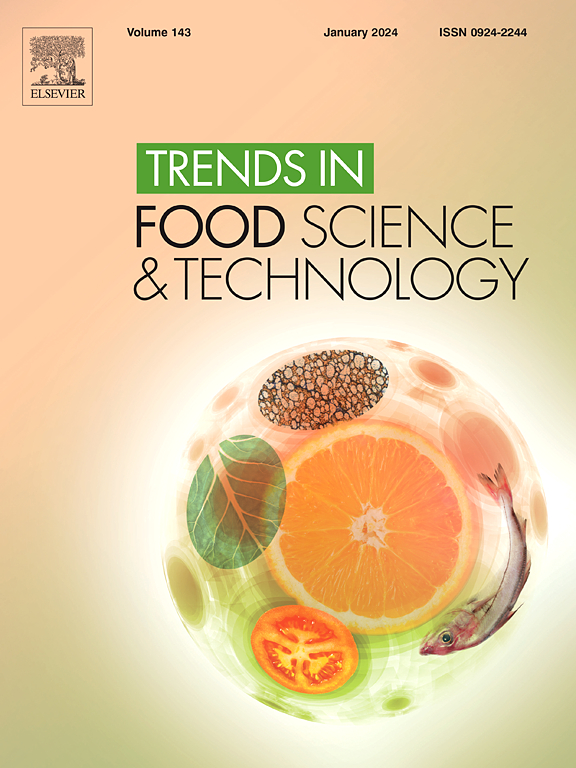Microbial engineering for Baijiu quality enhancement: Insights and perspectives
IF 15.4
1区 农林科学
Q1 FOOD SCIENCE & TECHNOLOGY
引用次数: 0
Abstract
Background
The structure of microbial community and their metabolic activities are key determinants of baijiu flavor. However, the diversity and succession of microbial communities within the fermenting system are significantly influenced by various factors, ultimately leading to variations in baijiu quality. Therefore, to achieve the precise production of high-quality baijiu, it is essential to understand the evolutionary dynamics and interaction mechanisms of microbial communities, and to rationally construct synthetic microbial communities.
Scope and approach
This review systematically summarizes recent advances in understanding the key factors driving microbial community evolution and the mechanisms of microbial interactions during Baijiu fermentation. It highlights the essential role of these regulatory factors in stabilizing the fermentation process and shaping the microbial community structure. Furthermore, the review explores the methods for constructing synthetic microbial communities, and proposes their applications and challenges in the context of precise control of baijiu fermentation.
Key findings and conclusions
Environmental factors and microbial interactions synergistically drive the dynamic succession of brewing microbiota, which plays a critical role in shaping the sensory characteristics of baijiu. The precise modulation of microbial communities represents a pivotal strategy for quality improvement. Through elucidating microbial origins and interaction mechanisms, the construction of functionally defined synthetic communities enables the targeted biosynthesis of flavor compounds. Future perspectives include the development of microbial strains, the assembly of synthetic communities, and the implementation of intelligent fermentation management strategies, all of which are essential for achieving precise process control in baijiu production.
微生物工程对白酒品质提升的启示与展望
微生物群落结构及其代谢活动是白酒风味的关键决定因素。然而,发酵系统内微生物群落的多样性和演替受到各种因素的显著影响,最终导致白酒品质的变化。因此,要实现高品质白酒的精准生产,必须了解微生物群落的进化动态和相互作用机制,合理构建合成微生物群落。本文系统地综述了白酒发酵过程中微生物群落进化的关键因素和微生物相互作用机制的研究进展。它强调了这些调节因子在稳定发酵过程和塑造微生物群落结构中的重要作用。此外,综述了构建合成微生物群落的方法,并提出了它们在白酒发酵精确控制中的应用和挑战。主要发现与结论环境因素和微生物相互作用协同驱动酿酒微生物群的动态演替,对白酒感官特性的形成起着关键作用。微生物群落的精确调节是质量改进的关键策略。通过阐明微生物起源和相互作用机制,构建功能明确的合成群落使风味化合物的靶向生物合成成为可能。未来的发展方向包括微生物菌株的开发、合成群落的组装和智能发酵管理策略的实施,这些都是实现白酒生产过程精确控制的必要条件。
本文章由计算机程序翻译,如有差异,请以英文原文为准。
求助全文
约1分钟内获得全文
求助全文
来源期刊

Trends in Food Science & Technology
工程技术-食品科技
CiteScore
32.50
自引率
2.60%
发文量
322
审稿时长
37 days
期刊介绍:
Trends in Food Science & Technology is a prestigious international journal that specializes in peer-reviewed articles covering the latest advancements in technology, food science, and human nutrition. It serves as a bridge between specialized primary journals and general trade magazines, providing readable and scientifically rigorous reviews and commentaries on current research developments and their potential applications in the food industry.
Unlike traditional journals, Trends in Food Science & Technology does not publish original research papers. Instead, it focuses on critical and comprehensive reviews to offer valuable insights for professionals in the field. By bringing together cutting-edge research and industry applications, this journal plays a vital role in disseminating knowledge and facilitating advancements in the food science and technology sector.
 求助内容:
求助内容: 应助结果提醒方式:
应助结果提醒方式:


